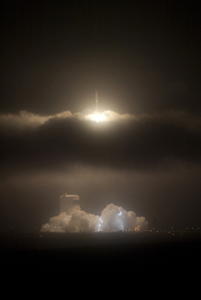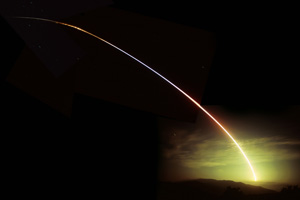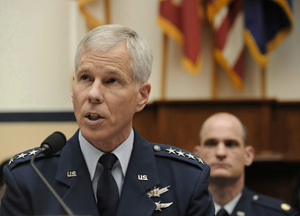When it comes to operations, space launch shapes up as a—and perhaps the—success story of today’s Air Force. USAF has reeled off 87 consecutive flawless rocket launches, each requiring, to quote Gen. William L. Shelton, head of Air Force Space Command, “many simultaneous near-miracles.” The Air Force hasn’t lost a payload to rocket failure since April 1999 and enjoys an unprecedented win streak of 13 years and counting.
This operational record, though, is only one factor in the overall calculus of success. In another critical area—cost—the picture is different. Critics warn that the rockets used to loft most military satellites are becoming unaffordable. They cite projections that national security launches over the next five years will cost $15 billion.

| ||
|
A United Launch Alliance Atlas V boosts an NRO payload into orbit at Complex 3, Vandenberg AFB, Calif., in September 2010. USAF has performed 87 successful national security launches in a row. (NRO photo) |
The specter of rising rocket costs confronts space officers with a dilemma. On one hand, they must act to keep launch expenses from crushing other programs. On the other, as Shelton told a National Space Symposium audience in Colorado Springs, Colo., “We don’t want to be found guilty of messing with success.” The upshot is turmoil—and a push for change—in the Air Force launch enterprise. Events now unfolding will determine how and from whom USAF will buy its rockets in the future, and whether the current streak of success will endure.
Launch costs are high—from $3,000 to $10,000 per satellite pound. The problem stems in part from the Evolved Expendable Launch Vehicle (EELV) program, comprising Delta IV and Atlas V boosters. These rockets are used for most national security space shots. They are expensive—$180 million apiece, said Shelton. Some put the tab higher. The $180 million figure, for instance, does not factor in a $1-billion-a-year mission assurance fee paid to the United Launch Alliance, a Boeing-Lockheed Martin venture that provides the boosters.
Hand-Bent Plumbing
The prices are escalating. “Left unchecked,” Shelton recently reported, the cost of each EELV will go up “somewhere on the order of 40 percent.” That increase—$72 million—would raise the cost of an Atlas V to $252 million, said Shelton. The same presumably holds true for the Delta IV. At these rates, Shelton noted, inflation in the space booster industry exceeds even the health care sector. USAF provides most EELV funding, but the National Reconnaissance Office and NASA kick in, too.
What is the cause of this troubling cost growth
When USAF started the EELV program in the 1990s, it forecast a robust US launch program, both government and commercial. Boeing and Lockheed Martin both bought big quantities of piece parts—engines and other booster components. Because of these economic order purchases, USAF benefitted from artificially low prices on its boosters.
The commercial launch market proved to be a bust, but for many years, the Air Force lived off the pool of cheap components. Now, that pool is drying up. Lower tier suppliers have vanished. Those that are left often cannot find parts, meaning they must be produced at premium prices. Another factor driving cost is old technology, says Shelton, particularly in the case of rocket engines. They are reliable and efficient, but are increasingly expensive to produce.
At a Federal Aviation Administration conference in February, Shelton took special note of upper stage engines. He said the fabrication of each Atlas Centaur and Delta RL10 power plant requires almost 8,000 man hours—more than needed to assemble a hand-built $400,000 Lamborghini luxury sports car. During manufacture, he said, workers hand-bend some 350 plumbing tubes for the combustion chamber and nozzle, using wooden frames as the guide.
Clearly, it’s time for change. The Air Force’s get-well plan comprises three approaches—contract certainty, competition, and new concepts.
The first area of concentration—as the Lamborghini anecdote attests—will be propulsion. Big rocket engines are the essential elements of spaceflight. The newest in the fleet is the RS68, used in the first stage of the Delta IV; it is almost 20 years old. The RD180 main engines for Atlas V stem from a 1970s Soviet design. RL10 engines date to the 1950s.
Space Command has begun internal studies to define a new upper stage engine design. It is years away, but the early line is that it will be easier and cheaper to manufacture. As an added benefit, it is expected to be more powerful and thus more reliable than today’s overtaxed engines. That might lead to reduced mission assurance measures, which are expensive.
The Air Force is not putting all its chips on technological breakthroughs to lower the cost of launch. In addition, it is now pressing forward with a new “block buy” strategy for acquisition of EELVs. This is expected to produce economic order quantities of parts at all levels of the supply chain, according to Shelton.
“We will contract for a certain number of Delta and Atlas core launch vehicles,” he said in early January, “which will in turn allow [ULA] to buy piece parts and raw materials at much lower rates.” He added: “This certitude in the business plan for our major launch vehicle provider should produce considerable savings over many years.” He estimates those savings could reach the level of “hundreds of millions of dollars.”
Specifically, Space Command has asked ULA to fill in a “matrix” square with prices it would charge for varied quantities of space boosters at different rates of production. Down one side of the matrix square would be five annual production rates—six, seven, eight, nine, or 10 rockets. Down another side would be three periods—three, four, or five years.
The production order thus could range from a low of 18 to a high of 50 boosters. USAF will be looking for a “sweet spot” of cost within those data.
Competitor Systems
For its part, ULA says it is doing everything it can do to keep costs down, having applied major cuts to its work force. Even so, it claims the block buy is essential. Speaking at the Colorado Springs event, Daniel J. Collins, ULA’s chief operating officer, said that “a block buy will significantly lower the cost of providing many of those launches with the same reliability and capability and flexibility.” At the same time, he asserted, “There are plenty of launches for new entrants, to establish themselves, to meet the criteria, and to be a part of this game. We welcome competition.”
The Air Force might conclude such a deal within a few months, if Congress goes along with it. In certain quarters, this is a controversial plan. Critics contend that it will damage prospects for other candidates to compete for Air Force launch business.

| ||
|
The launch that started the streak: A Titan IVB launches a national security payload into orbit on May 22, 1999, from Vandenberg AFB, Calif., in this series of time exposed photographs. (Photo by Brian Lockett via air-and-space.com) |
If ULA manages to lock in a huge number of future national security launches, warn critics, there would be few opportunities left for potential competitors. Thus, the chances of competition—and, presumably, lower cost—would disappear. Far better, say the critics, for the Air Force to immediately move toward open bidding on a per-launch basis.
Recent years have seen the emergence of private companies developing efficient, high-performance engines. One, Blue Origin, conducted a test that saw a full-size space vehicle rise 500 feet into the air and then settle softly to the ground, within inches of the planned touch-down spot. The potential value for Air Force operations is clear. Another company, SpaceX, has gone even further. It developed a completely new engine, the highly efficient and American-made Merlin 1D. Moreover, the firm has successfully flight-tested an EELV-class competitor, the Falcon 9 booster.
Even more interesting is SpaceX’s proposed Falcon Heavy rocket. It will be propelled by a package of three booster cores, with 27 engines firing at the same time. That will provide enough thrust to lift 117,000 pounds of payload—twice that which can be carried by today’s biggest EELV. SpaceX is shooting for first flight in 2013.
Many regard this huge booster as a likely defense launch entrant for the near future. Some regard it as a threat to today’s current crop of rockets, given what appears to be significantly lower cost. SpaceX officials claim that, if allowed to compete with ULA for launch business, it could save the Pentagon “at least one billion dollars” every year. Also to be watched is the impending debut of Orbital Sciences Corp.’s Antares medium-size rocket, marking the arrival of yet another space vehicle with the potential for EELV use.
The Air Force has not turned its back on these potential competitor systems. Far from it. Shelton said USAF is moving at a measured pace to bring in new entrants. He described competition as a tried-and-true tool for keeping costs in check.
The service has developed a new strategy to use designs from these new entrants once they’ve shown a level of reliability that gives USAF confidence it can safely use their products for vital and expensive national security payloads.
The immediate point of contention concerns exactly when the Air Force will allow new entrants to bid on medium- and heavy-lift space launches for national security payloads. In October 2011, the Air Force announced a new entrant certification strategy—a risk-based matrix for integrating new entrants. The following month, the service released its detailed plans for qualifying new bidders, titled New Entrant Certification Guide.
Erin C. Conaton, then undersecretary of the Air Force, called this plan “the best balance of ensuring reliable access to space while encouraging competition and innovation in the launch industry” and claimed USAF is “committed to providing a level playing field to all competitors.” Without doubt, the USAF view remains that it cannot afford a launch failure. In turn, mission assurance is the highest value, despite its cost. “Clearly, clearly, mission success is our No. 1 focus,” Shelton told the National Space Symposium. “We will continue to ensure that mission assurance corners are not cut. Let me say that again: We will continue to ensure mission assurance corners are not cut.”
Mission assurance demands highly expensive launch preparations. The awareness of risk drives demands for extensive and expensive launch reviews, by both the Air Force and industry. Examples of how rigorous mission assurance practices have prevented disaster are not hard to find. In March testimony to Congress, Shelton mentioned two:
MSgt. Michael Claus of USAF’s 5th Space Launch Squadron noticed a safety violation in equipment movement. By reporting it, he prevented damage to the Atlas V that was to boost the Navy’s Mobile User Objective System satellite.
SSgt. Paul Lillie of the 4th Space Launch Squadron detected a valve leak on an Atlas V preparing to launch an NRO spy satellite. This prevented the payload from being inserted into an improper orbit.
Space’s Bullish Future

| ||
|
Gen. William Shelton testifies before a House subcommittee on strategic forces. Shelton says mission assurance is AFSPC’s No. 1 focus. (USAF photo by Scott M. Ash) |
“There’s been a lot of talk about mission assurance, that maybe we’re paying too much for mission assurance, that maybe we can look at mission assurance and dial it back,” said Shelton. “Well, there will be tire treads over me on that one, if it comes to pass.”
As it grapples to constrain booster costs, the Air Force has embraced new operational concepts to make best use of existing systems. For instance, the service is seeking ways to squeeze more capability out of each blastoff. One idea: multiple-asset launch, the better to take advantage of the lifting power of the current Atlas and Delta rockets.
This first became possible in the mid-1990s, when USAF approved its EELV Secondary Payload Adapter, also known as an “ESPA ring.” The adapter allowed the big boosters to launch not only a 15,000-pound primary satellite but also as many as six small, 400-pound secondary satellites—all on the same vehicle.
Today, Air Force Space Command is ready to take matters one step further. It has decided that, when it makes operational sense, it will launch Global Positioning System III satellites two at a time, getting more bang for the launch buck. The Air Force has contracted with both ULA and SpaceX for ideas on how best to execute such dual launches. This “is a great way to save on overall launch costs,” Shelton said. “I can see multiple-launch concepts becoming more prevalent in these times of decreasing budgets.”
Finally, there is more willingness to recognize that not everything the Air Force launches is a truly critical payload. Shelton said there is room to consider a more relaxed—and less expensive—approach. “We launch a number of experiments, for example, in our space test program, and while we certainly value these experiments, it is clear that they aren’t in the same class as some of our satellites such as the Space Based Infrared [System] satellite,” said the general. “They may present an opportunity … to take a little bit more risk.”
For all that, space officials acknowledge that such steps will lower costs only at the margin. They say that any improvement is welcome, but fundamental change will require major technological breakthroughs. Toward this end, the Air Force has begun to pursue a number of transformational technologies. They hold the prospect of bringing a wholesale change in the military space business.
Shelton pointed out that, because today’s rockets are so expensive, USAF develops very large satellites with many types of capabilities, and builds them for very long service lives. This can also be a disadvantage. “By the time you reach end of life of the satellite on orbit, your sensor and computing technology can be anywhere from 20 to 30 years old,” said Shelton. “That’s a good 15 to 20 generations out of date.” Cheaper launch would open up design trades that could allow more frequent refresh of orbital technologies.
In the end, said Shelton, he is bullish on the future of the service’s capabilities. His goal is to make launch affordable, safe, and routine. In that future, he explained, “space launch is no longer an epochal event, but something that’s taken for granted much like an airline departure is today.”